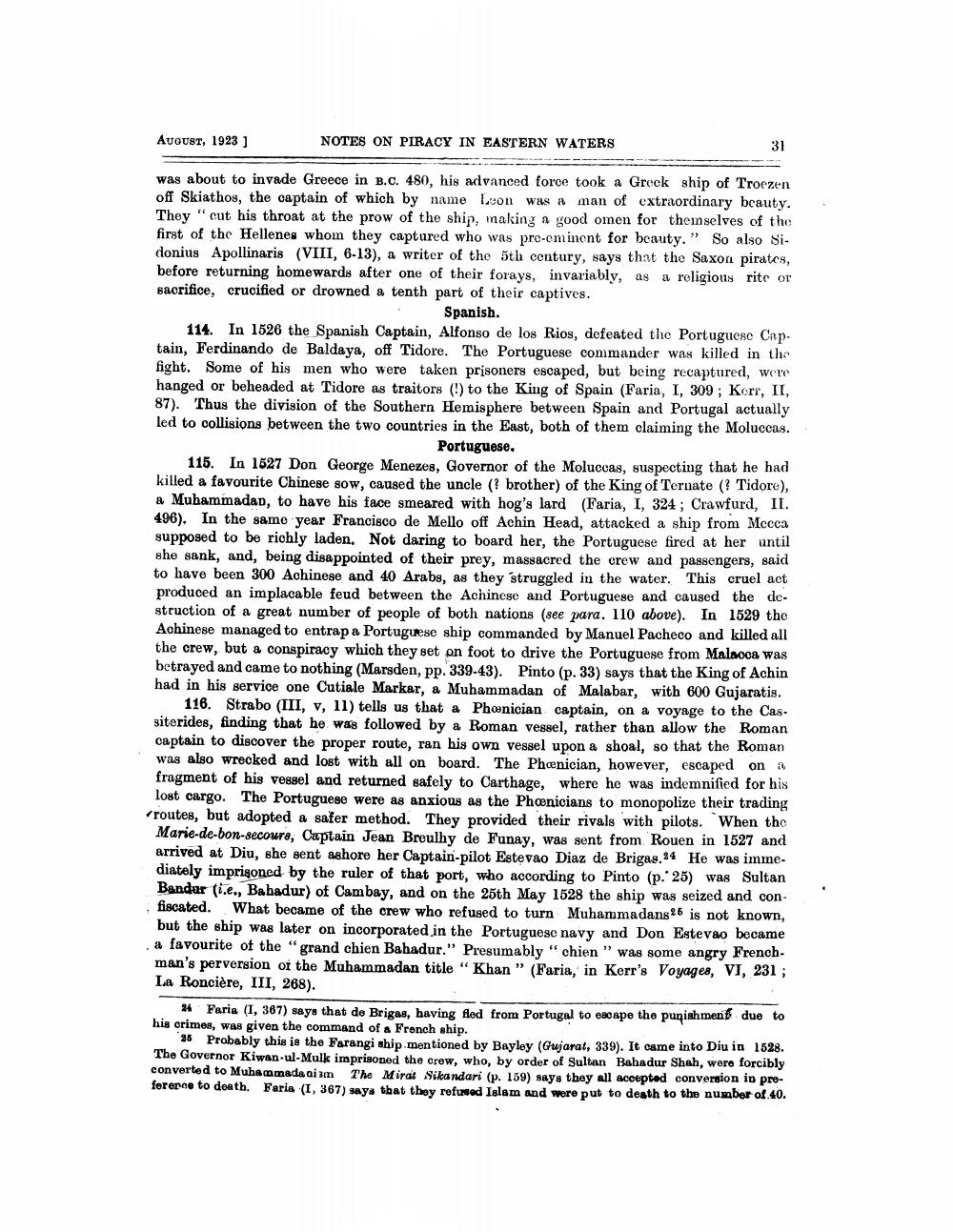________________
AUGUST, 1923)
NOTES ON PIRACY IN EASTERN WATERS
31
was about to invade Greece in B.C. 480, his advanced foroe took a Greek ship of Troezen off Skiathos, the captain of which by name Leon was a man of extraordinary beauty. They "cut his throat at the prow of the ship, making a good omen for themselves of the first of the Hellenes whom they captured who was pre-eminent for beauty.” So also Sidonius Apollinaris (VIII, 6-13), a writer of the 5th century, says that the Saxon pirates, before returning homewards after one of their forays, invariably, as a religious rite or sacrifice, crucified or drowned a tenth part of their captives.
Spanish. 114. In 1526 the Spanish Captain, Alfonso de los Rios, defeated the Portuguese Cap. tain, Ferdinando de Baldaya, off Tidore. The Portuguese commander was killed in the fight. Some of his men who were taken prisoners escaped, but being recaptured, were hanged or beheaded at Tidore as traitors (!) to the King of Spain (Faria, I, 309; Kerr, II, 87). Thus the division of the Southern Hemisphere between Spain and Portugal actually led to collisions between the two countries in the East, both of them claiming the Moluccas.
Portuguese 115. In 1627 Don George Menezes, Governor of the Moluccas, suspecting that he had killed a favourite Chinese sow, caused the uncle ( brother) of the King of Ternate (? Tidore), a Muhammadan, to have his face smeared with hog's lard (Faria, I, 324; Crawfurd, II. 496). In the same year Francisco de Mello off Achin Head, attacked a ship from Mecca supposed to be richly laden. Not daring to board her, the Portuguese fired at her until she sank, and, being disappointed of their prey, massacred the crew and passengers, said to have been 300 Achinese and 40 Arabs, as they struggled in the water. This cruel act produced an implacable feud between the Achinese and Portuguese and caused the destruction of a great number of people of both nations (see para. 110 above). In 1529 tho Achinese managed to entrap a Portuguese ship commanded by Manuel Pacheco and killed all the crew, but a conspiracy which they set on foot to drive the Portuguese from Malaoca was betrayed and came to nothing (Marsden, pp. 339-43). Pinto (p. 33) says that the King of Achin had in his service one Cutiale Markar, a Muhammadan of Malabar, with 600 Gujaratis.
116. Strabo (III, v, 11) tells us that a Phoenician captain, on a voyage to the Cas. siterides, finding that he was followed by a Roman vessel, rather than allow the Roman captain to discover the proper route, ran his own vessel upon a shoal, so that the Roman was also wrecked and lost with all on board. The Phænician, however, escaped on a fragment of his vessel and returned safely to Carthage, where he was indemnified for his lost cargo. The Portuguese were as anxious as the Phoenicians to monopolize their trading routes, but adopted a safer method. They provided their rivals with pilots. When the Marie-de-bon-secours, Captain Jean Breulhy de Funay, was sent from Rouen in 1527 and arrived at Diu, she sent ashore her Captain-pilot Estevao Diaz de Brigas 24 He was immediately imprigoned by the ruler of that port, who according to Pinto (p. 25) was Sultan Bandar to.e., Bahadur) of Cambay, and on the 25th May 1528 the ship was seized and con fiscated. What became of the crew who refused to turn Muhammadans 25 is not known,
but the ship was later on incorporated in the Portuguese navy and Don Estevao became . a favourite of the "grand chien Bahadur." Presumably "chien " was some angry Frenchman's perversion of the Muhammadan title “Khan " (Faria, in Kerr's Voyages, VI, 231; La Roncière, III, 268).
24 Faria (1, 367) says that de Brigas, having fled from Portugal to ea ape the punishment due to his orimes, was given the command of a French ship.
36 Probably this is the Farangi ship mentioned by Bayley (Gujarat, 339). It came into Diu in 1628. The Governor Kiwan-ul-Mulk imprisoned the crow, who, by order of Sultan Bahadur Shah, were forcibly converted to Muhammada im The Mirat Sikandari (p. 159) says they all accepted conversion in proforence to death. Faria (I, 367) says that they refused Islam and were put to death to the number of 40.




